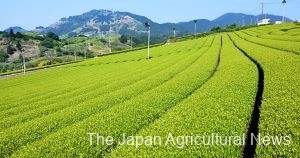
Tea trees are planted to form a Chinese character meaning tea on the mountain overlooking tea plantations. The new green tea leaves were ready for the first pick. (in Kakegawa City, Shizuoka Prefecture)
Agriculture journalist Ayumi Kotani visits sites in Japan designated as Globally Important Agricultural Heritage Systems (GIAHS).
One region in Shizuoka Prefecture maintaining its GIAHS-recognized Chagusaba Farming Method is now busy plucking the first flush tea leaves. It’s also one of the most active seasons for the fresh green tea gardens to welcome many tourists.
■ ■
Kawanehon Town is located in a mountainous area near the upper Oi River. Tetsuro Tsuchiya (83) and his eldest daughter Yuko (59) were busy covering their Yabukita tea trees at the Tsuchiya Tea Farm, which is known as the “tea garden in the sky.” They plan to enter the carefully-grown tea leaves in this year’s exhibition.
Covering the tea trees for approximately ten days before picking allows young leaves grow in the shade and become superior quality green tea with a mild and rich flavor.
The furrows in the garden were covered with dried pampa and other grass, which gave my feet cushiony comfort. This traditional farming system is called Chagusaba Farming Method. Chagusaba is a semi-natural grassland surrounding the tea plantation. It’s used to grow chagusa (semi-natural grass) to cover the furrows in the tea fields. (In Japanese, “cha” means tea, “gusa” or “kusa” mean grass, and “ba” means a place.)
“This tea plantation is located at an altitude of 600 meters. We use chagusa to protect it against the winter chill and mitigate soil erosion,” said Tetsuro, imparting the wisdom of the seasoned farmer growing tea on the steep slopes.
Tetsuro won the first prize (Farm Ministry’s Prize) at the National Tea Exhibition Fair not just once but twice. He is an absolute Japanese tea legend.
Yuko, who grew up looking at her father, left home after marriage but decided to come home with her husband to succeed the family business. “My father was 69 when he won his first ministry’s prize. He graduated junior high and worked hard for more than 50 years, and then for the first time, his work was recognized as the best in Japan. That’s something,” she said while looking at Tetsuro’s back.
Last year, the Tsuchiya Tea Farm built a terrace overlooking the tea garden. I also took the opportunity to enjoy a cup of beautiful green tea on the terrace, which is already popular among visitors from urban areas and other countries.
It was not just a cup of tea but something precious that represents the Japanese spirit and original landscape. The tea prepared delicately using low-temperature hot water was rich and fragrant. I thoroughly enjoyed the top-down view of the shining tea fields, the early summer breeze, and the song of a bush warbler.
■ ■
The green tea terrace provides a great view, time, and spaciousness centered on tea. One of the GIAHS-designated cities, Kakegawa, focuses on first-hand experiences that appeal to human’s five senses in order to upgrade the value of green tea.
Koichi Yamada (57) runs an old Japanese-style inn called Tabinoya. He returned to Kakegawa after working in the travel industry and running a private lodging. When he saw the tea fields, he felt the scenery was as good as that of Biei, a popular tourist site in Hokkaido. “The best thing to see in this region is the farmer maintaining this landscape,” he emphasized. However, the tea fields are most beautiful when the farmers are the busiest picking the first flush tea leaves. So, he’s created a council to train local tour guides to support tourists and farmers.
■ ■
The Chagusaba Farming Method is a system developed by local farmers to make top quality tea by utilizing grass as a resource. It requires enormous labor to cut grass, but that helps nurture various living things and create attractive landscapes. This “traditional tea-grass integrated system” has been recognized globally as an agricultural practice that harmonizes well with nature and satisfies the Sustainable Development Goals (SDGs) principles. (Photos by Sae Kamae & Takuro Fukumoto)
The locals cut, dry, and put grass in the furrows to keep soil moisture and temperature levels, control weed, make soil more organic, and store carbon. Cutting chagusa in autumn and winter every year makes it easier for over 300 species of plants to grow and some endangered species, like Kakegawa Fuki Locust (Parapodisma awagatakensis), to live. That way, the region successfully preserves biodiversity while producing high-quality tea. This whole system was designated as a GIAHS site in 2013 and the designated tea area are four cities and one town (Kakegawa City, Kikugawa City, Shimada City, Makinohara City, and Kawanehon Town).

